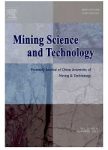A fatigue damage model for rock salt considering the effects of loading frequency and amplitude
A fatigue damage model for rock salt considering the effects of loading frequency and amplitude作者机构:State Key Laboratory of Disaster Prevention & Mitigation of Explosion & Impact College of National Defense Engineering PLA University of Science & Technology State Key Laboratory for Geomechanics & Deep Underground Engineering China University of Mining & Technology
出 版 物:《International Journal of Mining Science and Technology》 (矿业科学技术学报(英文版))
年 卷 期:2016年第26卷第5期
页 面:955-958页
核心收录:
学科分类:081901[工学-采矿工程] 0819[工学-矿业工程] 08[工学]
基 金:fundings and supports of the National Basic Research Program of China (No. 2013CB036005) the National Natural Science Foundation of China (Nos. 51309234, 51527810, 51304219, and 51021001) the Natural Science Foundation of Jiangsu Province of China (No. BK20130065) the Open Foundation of State Key Laboratory for Geomechanics and Deep Underground Engineering of China (No. SKLGDUEK1403) the China Postdoctoral Science Foundation (No. 2015M570451)
主 题:Rock salt Fatigue Frequency Stress amplitude Damage
摘 要:With the large-scale construction of underground gas storage in salt deposit, much more efforts have been made to assess the fatigue properties of rock salt. The fatigue damage processes the primary, steady,and accelerated phases, which is similar to the axial irrecoverable deformation compiled from the loci of the loading cycles of rock salt. The cumulative fatigue damage increases with a decrease in the loading frequency and with an increase in the stress amplitude within the range tested. To take into account the effects of loading frequency and amplitude on the fatigue behavior of rock salt subjected to cyclic loading, a low cycle fatigue damage model was exclusively established combined with the Manson–Coffin formula. The proposed damage evolution equation was validated with experimental results and proved to be efficient in the prediction of fatigue damage tendency of rock salt under different loading frequencies and amplitudes.



